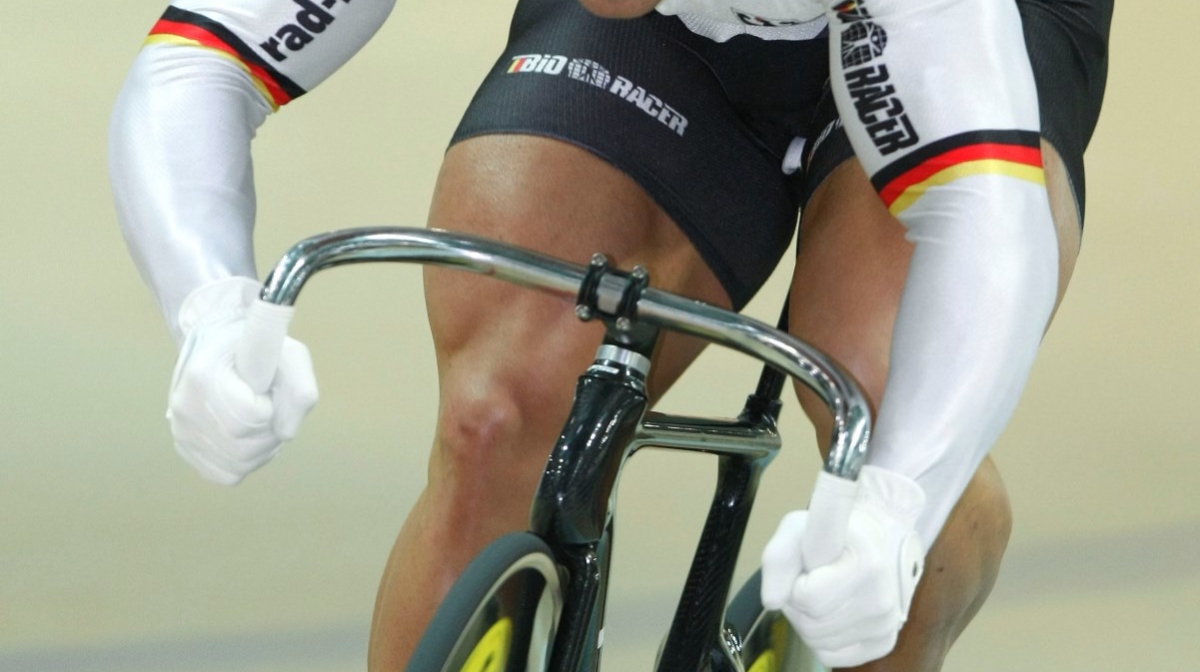A common question asked by many beginner cyclists, fitness enthusiasts and physique-conscious athletes of all ages, is ‘will cycling make my legs big?’ , and the short answer is ‘it depends.’ It depends on your genetics, the amount of calories you take in, the type of cycling you do and the gears you ride in. After all there are a myriad of ways that can and will affect how someone’s body reacts to exercise.
This article is designed to give an insight into two main groups of people: those who are worried about putting size on their legs and want to reduce the amount of hypertrophy and muscle volume growth, and those who wouldn’t actually mind developing thighs like Hoy and want to know what they can do to maximise hypertrophy and muscle growth.
Let’s make this clear – getting huge legs from cycling is difficult.
First of all, I’d just like to get a simple preconception out of the way: cycling will not immediately give you thighs like Robert Förstemann. You will not experience super-natural levels of muscle growth from a few weekend bike rides, or even a tough track day. Thighs like that come from years of slogging it out in a tough gear, constantly grinding it out against resistance for extended periods of time on the track or roads.
But this isn’t all that’s making some professional track cyclist’s legs grow, there’s also the lower-body strength training they undertake, which, whilst still in the strength rep ranges (1-6) and not focussed on size, will allow them to push harder on the track, this undoubtedly leads to more muscle growth as a result of time under tension.
But that’s also not all, track cyclists will have a predefined idea of how powerful and ‘big’ they want to be, so they’ll be on a strict calorie-specific diet allowing them to overload on calories if they need to. It doesn’t matter how much cycling or resistance work you do, without the excess of calories, you won’t grow, it’s as simple as that.
So far on our check-list for muscle-building factors in cycling, we have prolonged resistance in a big gear, lower body weight training and an excess of calories, but there’s one more defining factor, and it’s the biggest of them all when it comes to building muscle: genetics.
Genetics are the reason that when Bradley Wiggins puts on weight to race track, he’s still relatively slim compared to say Chris Hoy or Robert Förstemann.

Robert Förstemann (image source: www.Roth-Foto.de)
These two guys are simply built different genetically, their genes are telling their bodies to do different things: Wiggins’ likely wants him to stay at a lighter BMI, and Förstemann’s at a higher one. On a side note: there’s also the height difference, at around 5’8”, Förstemann’s frame needs to pack in a lot of weight and muscle to even content with Wiggins who, although significantly lighter, at 6’3” has longer legs for turning the gears, and will find it easier to stay within an efficient power-to-weight ratio.
So by now you’re asking: ‘will cycling give me big legs?’. You can follow the lifestyle and training routine of the track pros, but you should always be conscious of your metabolism, genes and what you’re putting in your mouth.
What to do if you’re not gaining the muscle you desire through cycling:
- Up the calories (not just any calories, but protein-rich foods complemented by hearty portions of wholemeal carbs to prevent muscle being burnt during hard sessions.)
- Try adding in a cycling-specific strength training routine to build muscle. You can switch the rep range to 8-12 to build size, but always make sure you’re staying functional with the added weight, you don’t want to slow yourself down.
- Work against a harder gear for a session a week, then for two sessions a week; you’ll soon see that the added resistance causes a reaction from the muscle. If it doesn’t, repeat step one.
Now for the cyclists who want to maintain weight and stay light.
As a cyclist, one of your main goals is to keep in good shape. Being in good shape can mean very different things to different people, but if you spend a lot of your time tackling mountain climbs and 3-4 hour rides, then being in good shape will mean being light.
Being light means keeping body fat levels to a minimum and getting rid of excess muscle . The usual solution for cyclists is to eat no more than they will burn off in their rides, whilst keeping the food high-quality and optimum for recovery. Say a cyclist burns 2,000 kcal on a ride, they will make sure they only eat that same amount throughout the day, leaving their overall calorie count at zero.
As scary as that may sound, it’s not about starving yourself at all, it’s about making sure that you’re getting the full spectrum of vitamins and nutrients from the reduced calories you’re taking in. So even though you may not be overeating, it’s important to refuel and give your body back the nutrients it needs to recover. This means taking in adequate amounts of protein, carbs and fats, whilst being sure to recover with supplements immediately after rides for optimum nutrient timing.
What to do if you’re holding onto too much muscle weight:
- Reduce the calories. Now this should be taken with caution, for any endurance athlete (pro or amateur), dangerously cutting calories is never good for your health. Experiment with small incremental reductions until you hit that sweet spot between ‘still not losing weight’ and ‘losing weight but performance is seriously going downhill’. When you do cut, cut the carbs, your body will begin to eat excess muscle when it runs out of fuel.
- Avoid using medium to heavy resistance work, keep any strength work to bodyweight exercises and lightweight resistance.
- Add in a run or two a week (depending on your schedule.) to facilitate extra calorie burning, the extra muscle should start to drop off you. You can also get some cycling-strength and postural benefits from running.
- Still not shifting? It’s possibly the diet…
Remember: everyone has completely different genetics.
Know your body, know that if you’re 5’10” you need to add extra muscle to compete with riders at 6’2”. Know how your metabolism works, and experiment using the tips above to achieve your desired result.
- If you’re interested, check out our supplements which will help you build and maintain mass, by clicking here.
- If you’re interested in maintaining your physique or slimming down, rather than building mass, you might want to read further down, and explore our energy and nutrition range here.
- If you want to explore our range of products to aid your cycling, please join us at probikekit.co.uk!
Please, let us know your aims and goals, leave a comment below and join the discussion!

